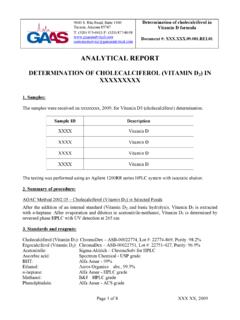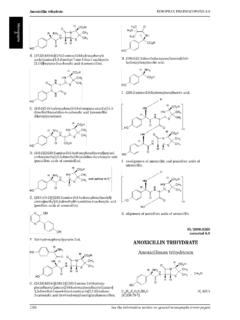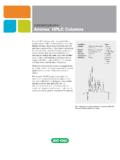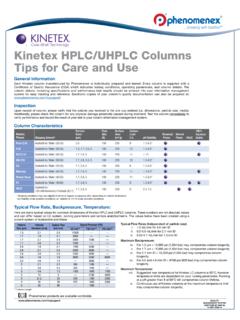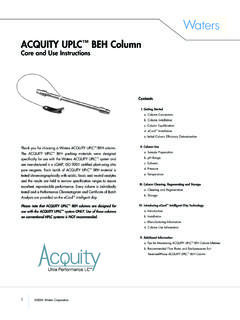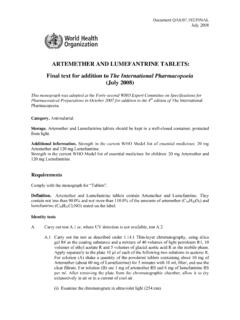Transcription of Liquid-liquid extraction combined with high performance ...
1 *Correspondence: P. P. Maia, Laborat rio de An lises Toxicol gicas, Departa-mento de An lises Cl nicas e Toxicol gicas, Universidade Federal de Alfenas, Rua Gabriel Monteiro da Silva, 700, - Alfenas - MG, Brazil. E-mail: Journal of Pharmaceutical Sciencesvol. 47, n. 2, , 2011 Liquid-liquid extraction combined with high performance liquid chromatography-diode array-ultra-violet for simultaneous determination of antineoplastic drugs in plasmaAnanda Lima Sanson1, Su llen Cristina Renn Silva1, Matheus Coutinho Gon alves Martins1, Alexandre Giusti-Paiva2, Patr cia Penido Maia1*, Isarita Martins11 Faculty of Pharmacy, Laboratory of Toxicological Analysis, Federal University of Alfenas, 2 Institute of Biomedical Sciences, Federal University of AlfenasA Liquid-liquid extraction (LLE)
2 combined with high- performance liquid chromatography-diode array detection method for simultaneous analysis of four chemically and structurally different antineoplastic drugs (cyclophosphamide, doxorubicin, 5-fluorouracil and ifosfamide) was developed. The assay was performed by isocratic elution, with a C18 column (5 m, 250 x mm) and mobile phase constituted by water pH acetonitrile-methanol (68:19:13, v/v/v), which allowed satisfactory separation of the compounds of interest. LLE, with ethyl acetate, was used for sample clean-up with recoveries ranging from 60 to 98%. The linear ranges were from to 100 g mL-1, for doxorubicin and 1 to 100 g mL-1, for the other compounds. The relative standard deviations ranged from to This method is a fast and simple alternative that can be used, simultaneously, for the determination of the four drugs in plasma, with a range enabling quantification of the drugs in pharmacokinetics, bioequivalence and therapeutic drug-monitoring : Antineoplastic drugs/simultaneous determination in plasma.
3 Liquid-liquid extraction . High- performance liquid chromatography/diode array m todo de extra o l quido-l quido (ELL) combinado com cromatografia l quida de alta efici ncia-detector de arranjo de diodos foi desenvolvido para an lise simult nea de quatro f rmacos antineopl sicos quimicamente e estruturalmente diferentes (ciclofosfamida, doxorrubicina, fluoruracila e ifosfamida). O estudo foi realizado sob condi es isocr ticas, com coluna C18 (5 m, 250 x mm) e fase m vel constitu da por gua pH (68:19:13, v/v/v), que permitiu separa o satisfat ria dos analitos de interesse. A ELL, com acetato de etila, foi utilizada para limpeza da amostra, com recupera o variando de 60 a 98%. As faixas foram lineares de 0,5 a 100 g mL-1 para doxorrubicina e 1 a 100 g mL-1 para os outros compostos.
4 O desvio padr o relativo variou de 5,5 a 17,7%. Este m todo uma alternativa r pida e simples que pode ser usado, simultaneamente, para a determina o dos quatro f rmacos em plasma, com uma faixa que permite quantific -los em estudos de farmacocin tica, bioequival ncia e monitoriza o terap : F rmacos antineopl sicos/determina o simult nea em plasma. Extra o l quido-l quido. Cromatografia l quida de alta efici ncia/detector de arranjo de agents are drugs used in chemothe-rapy which are not selective for cancer cells since they also affect the growth and reproduction of healthy cells. According to the International Agency for Research on Cancer (IARC), at least nine alkylating cytostatic drugs are classified as carcinogenic to humans (Group 1).
5 In addition, several drugs are classified by the IARC into Groups 2A and 2B (probably and possibly carcinogenic to humans, respectively). The optimal dose should produce a maximal anti-tumor effect with acceptable levels of toxici-A. L. Sanson, S. C. R. Silva, M. C. G. Martins, A. Giusti-Paiva, P. P. Maia, I. Martins364ty. In clinical practice, these drugs frequently cause toxic effects that would be considered unacceptable. Although toxicity is commonly regarded as the most important effect to control, partly because it is easier to measure, the risk of under-dosing and reduced efficacy must also be con-sidered. In most of the current chemotherapy protocols, antineoplastics are used as a combination of agents having different mechanisms of action in order to decrease the dose of each agent individually thus keeping the synergism of therapeutic effects and minimizing the toxic effects (Turci et al.)
6 , 2003)Combination chemotherapy is administered in order to target as many types of cells in the tumor as possible. Selection of agents for combination chemotherapy regi-mens involves consideration of drug-specific factors such as mechanism of action, antitumor activity, and toxicity profile. Drugs that possess minimally overlapping mecha-nisms of action and toxicities are combined when possible (Kamil et al., 2010).Nevertheless, as a consequence, patients may be exposed to a wide variety of substances and few methods have been described for the simultaneous determination of these drugs in plasma (Roberts et al., 2006; Turci et al., 2002; Kaestner, Sewell, 2007). In the present study, a single method was developed to determine four substances with toxicological significance in (CP), 2-bis(2-chloroethyl) aminotetrahydro-2H-1,3,2-oxazophosphorin e-2-oxide, is one of the most commonly used antineoplastic alkylating agents.
7 It has also been used due to its immunosuppressi-ve properties in the treatment of autoimmune diseases as well as in renal and bone marrow transplants. CP has been classified as a human carcinogen (Group 1) by the IARC. Ifosfamide (IF), 3-(2-chloroethyl)-2-[(2-chloro-ethyl)ami no] tetrahydro-2H-1,3,2-oxazaphosphorin-2-ox ide, is a structural analogue of CP having alkylating activity after enzymatic activation to cytotoxic compounds. IF differs from CP in the transfer of one 2-chloroethyl group from the extracyclic to the endocyclic nitrogen. This results in differences in pharmacological and toxicological pro-perties. Although IF has been shown to be carcinogenic in animals, there is no evidence of its carcinogenicity in humans and it is therefore included by the IARC in Group 3.
8 Both cyclophosphamide and ifosfamide are widely used in the treatment of non-Hodgkin lymphomas and a variety of bone and soft tissue sarcomas. The pharmacological profile of these drugs is important and, in order to gather this information, reliable methods for the determination of oxazaphosphorines and their metabolites are necessary when determining optimal dosages (Turci et al., 2003; Ekhart et al., 2007; Baumann, Preiss, 2001).Doxorubicin (DOX) is classified as an anthracycli-ne, a glycosidic derivative of tetra-hydronaphthacene that belongs to the tetracycline class of antibiotics. The antineoplastic activity of these drugs has been mainly attributed to their strong interactions with DNA in target cells.
9 These drugs can deform DNA structure and termi-nate its biological function. Furthermore, they can be reduced to their semiquinone form by biological reducing agents, such NADH and NADPH. Free radicals can be generated, which can attack cell components, such as membrane and DNA, and halt cell growth. According to the IARC, these agents are probably carcinogenic to humans (Group 2A). There is inadequate evidence of carcinogenicity in humans, but sufficient evidence of carcinogenicity in animals (Turci et al., 2003; Ekhart et al., 2007).The drug 5-fluorouracil (5-FU), 5-fluoropyrimidine-2,4-dione, is an antimetabolite frequently used in the treatment of malignancies including cancers of the gas-trointestinal tract, lung, and breast.
10 It acts as a competitor of pyrimidine and needs to be converted to the nucleotide level so as to exert its effect. 5-FU is classified as Group 3 (not classifiable as to carcinogenicity to humans) by the IARC based on inadequate evidence of carcinogenicity in humans and animals (Turci et al., 2003).Several methods have been described in literature for environmental and biological monitoring of anti-neoplastics. The majority of the papers have described methods employing HPLC, using various detector types. Antracyclines and 5-FU can be determined by HPLC with fluorescence and UV detection, respectively. Sample extracts were injected into a C18 reversed-phase column with a proportion of organic solvent and buffer as mobile phase.










